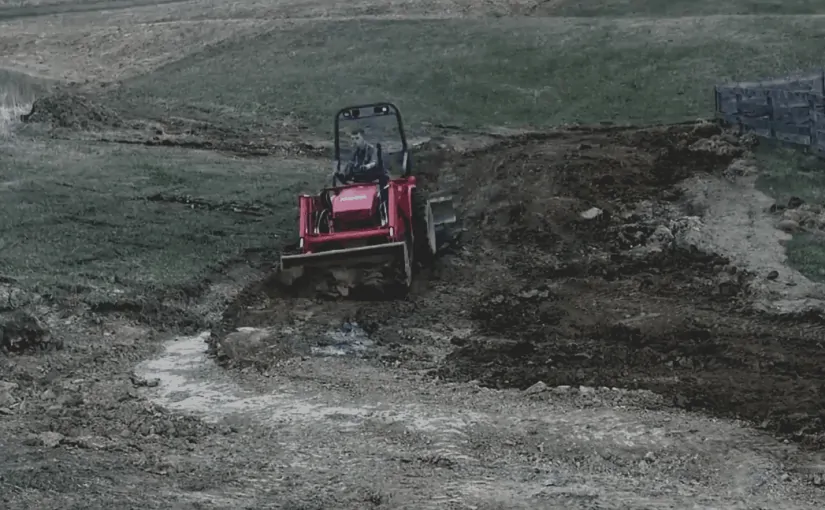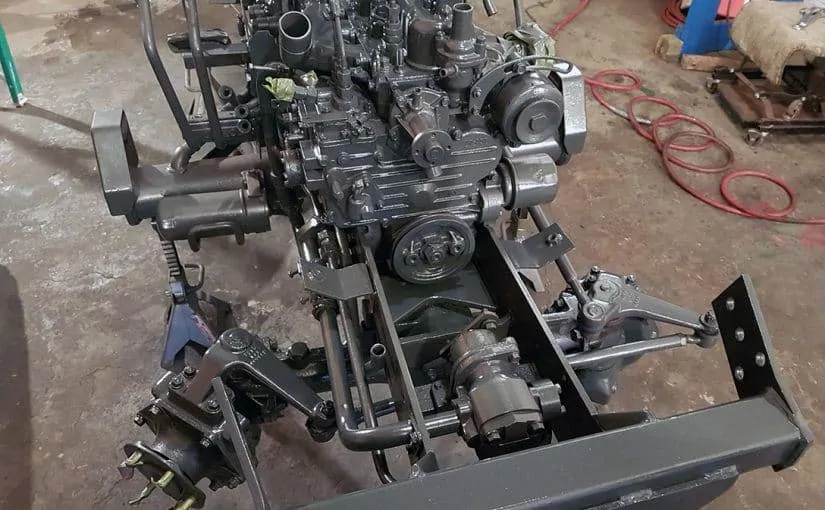I am using my Kubota B20 front end loader to cut in some new storm ditches and install culverts alongside my driveway and access roads. I made a custom tooth bar similar to the Piranha Bar out of scrap steel, and it has been working very well.
Continue reading Digging Storm Ditches & Driveway CulvertsTag: Kubota B20
Restoring a Kubota B20 Tractor – Part 8
Another video update! This was filmed a while ago but I just finally got around to editing it down. I also filmed the method I used to load the back tires with 48 gallons of windshield washer fluid. It was easy!!
The tractor has been running great and has been coming in very handy the last several weeks.
Loading Tractor Tires Quick & Easy
Loading your tractor tires with windshield washer fluid is an easy upgrade giving more traction, better hill stability, and additional weight / ballast. This is also helps with using a front end loader. I decided to use windshield washer fluid since it is inexpensive, easy to obtain, will not freeze, and will not corrode the wheels like calcium and some of the other wheel ballast options.
Restoring a Kubota B20 Tractor – Part 7
Video progress update!
First startup after initial 30-minute run-in and head bolts re-torqued. Now starting to apply load to break in the engine and seat the piston rings.
This is the first time the tractor has moved under its own power in many years! Entire chassis has been split, separated, cleaned up, restored and painted.
Also talk about some of the remaining issues that still need addressed in the steering column, and the front gear case on the left side wheel.
Kubota Finally B20 Moves Under its Own Power!
Video progress update!
First startup after initial 30-minute run-in and head bolts re-torqued. Now starting to apply load to break in the engine and seat the piston rings.
This is the first time the tractor has moved under its own power in many years! Entire chassis has been split, separated, cleaned up, restored and painted.
Continue reading Kubota Finally B20 Moves Under its Own Power!
Restoring a Kubota B20 Tractor – Part 6
Spring is knocking at the door, and I am not ready! I have several projects already lined up that I want to use this tractor for, so I need to get it finished up! That said, I still want to paint it since it is disassembled and it is a new skill I want to learn.
I separated all the orange bits from the blue bits, so I could cut down on much of the masking and do a better job at the transitions. I had to figure out a way to lift the loader off without being able to use its own hydraulics (which is how they always seem to be removed on YouTube). I put it in a sling with a ratchet strap and lifted with my engine hoist. I put the rear tires back on the tractor, a rolling hydraulic jack under the front, and rolled the chassis out from under it.
Sidenote – I am not sure why I always end up doing these things in the least efficient order! If I had just removed the loader in the very beginning 1) the tractor would still had both axles and rolled out from under it much easier and 2) removing the front axle / engine would have been so much smoother not working around the loader arms.
Then I welded up some scrap steel to support it using the wedge bolt pin holes. I had to add a strap to keep my support pins from wanting to walk out when working on it, and another to keep the main arm cylinder from wanting to expand & tipping my support stands over.


These machines have a lot going on under those fenders!

Now I am sanding out as many of the blemishes as I can. I have some new decals on order, and hopefully will soon be laying down some nice shiny new paint.
It’s been several weeks since the last update, and I really was hoping the next update would be a running engine. Unfortunately I had a setback on that, which I will get into shortly. This one is going to be a double update!
First up is that the engine and chassis painted up very nicely. I painted the engine and each of the disassembled chassis sections separately, and then again after having them re-assembled. This allowed me to get better coverage on each section, and then the additional coats after assembly took care of the scratches from re-assembly that are bound to happen.

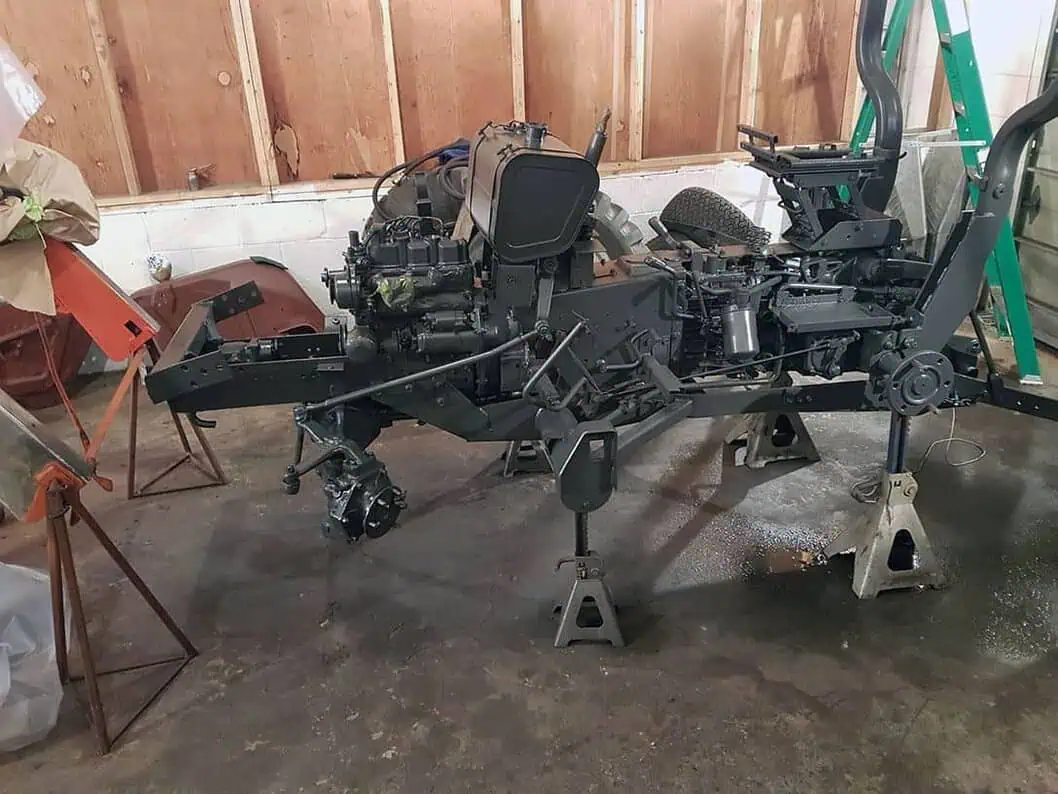

The cherry picker / hydraulic shop crane has proven invaluable for this project. Besides the normal engine pulling / installation, I have been able to use heavy ratchet straps to sling larger assembly’s like the entire front end loader and the front axle / chassis sub-frame. With careful control of each ratchet strap, I was able to pitch the assembly just how I needed and then line up the frame bolt holes for assembly completely by myself. Even with the aid of several big guys, I do not think that could have been done very easily without it!
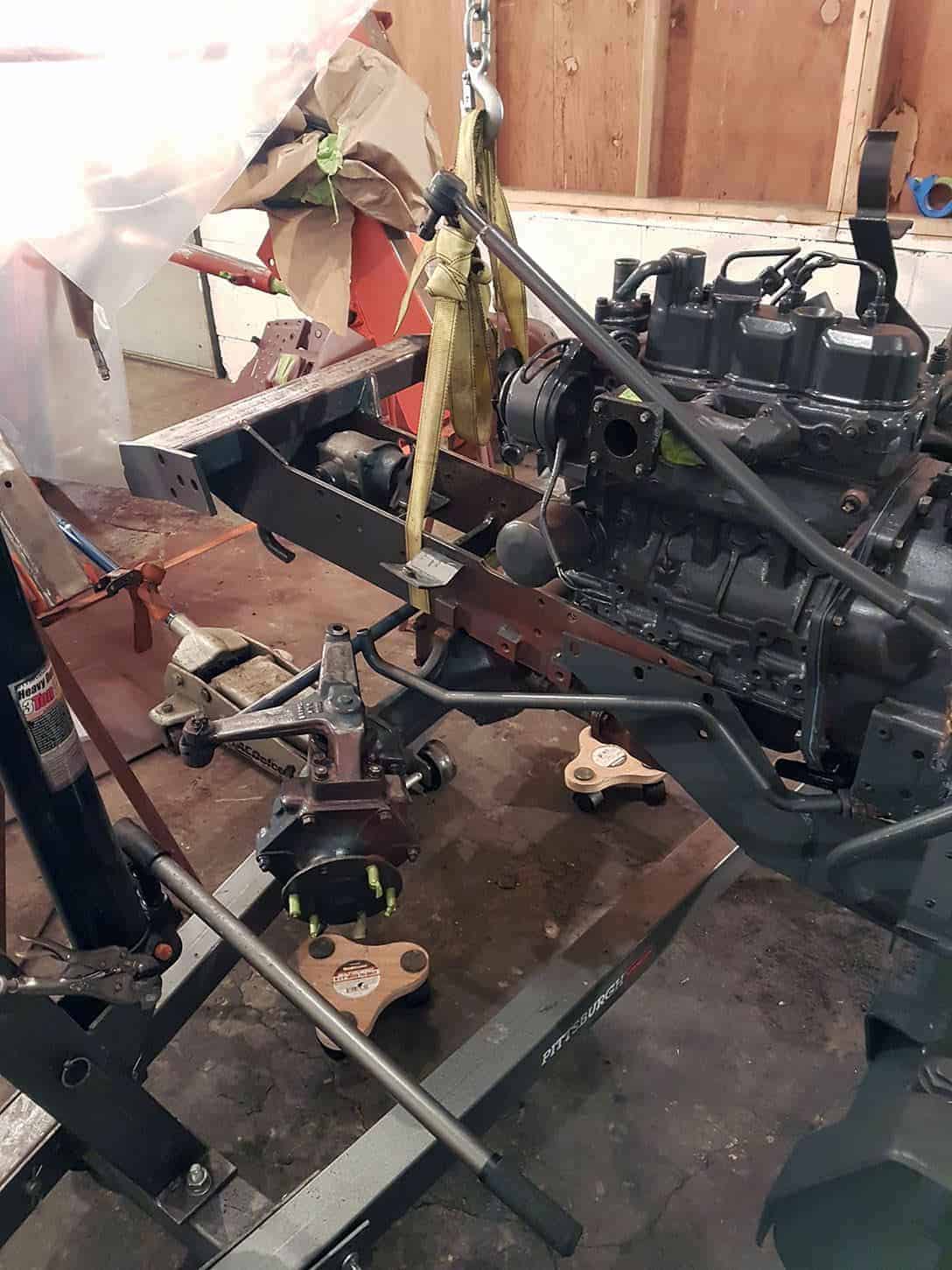
Once the engine and chassis were all bolted back up, I wanted to test fire the engine before assembling it any further.

I hooked up the minimum connections needed in order to get fuel to the injection pump, and power to the glow plugs and starter. I did not have the radiator installed yet, so I would only be able to run the engine briefly. I also had a scrap piece of wood handy to suffocate the intake with, just in case I did not get all the governor springs inside the injection pump reinstalled correctly.
I bled the air out of each of the injection lines, energized the glow plugs, and cranked it over. Sadly it wouldn’t start. I gave it several attempts and re-bled the injector lines just in case they still had too much air. Eventually I gave up for that night. Later I took the injectors back out for a compression test. I was seeing compression of about 200 psi on #1 and #3, and only 90 psi for cylinder #2. I double checked the valves were adjusted correctly, as that can also give low compression, but all was good there.
I began to suspect the head was cracked from overheating. I know the engine had a history of overheating before it was taken out of service 9 years ago, and likely ran without coolant on at least one occasion due to the cracked T-stat housing I found.
When I had it apart, the cylinder head was warped (about 8 thousands out). I was able to re-surface it myself following YouTube videos, and brought back to within 2 thousands of being flat, which is the workshop manual spec. I also lapped the valves, and was not able to visually see any cracks at that time.
It did not really make sense to have it sent into a shop to be magnafluxed, as the #2 cylinder was pretty eroded, and these heads are cheap enough that if it was cracked a new head from eBay would likely be the same cost or less than repair work on the head. Given that, and the eroded #2 head area, it would not make sense to spend a lot of money repairing this head. But since I didn’t see any cracks at the time, I was willing to invest in a head gasket to give it a shot.
Later after it was all assembled and I had painted the engine, I noticed a crack on the external surface of the head. It appeared to be only in the water jacket area, so I put epoxy on it and tried to forget it was there to ease my mind! But now that my compression is low, the most obvious answer is there were additional cracks that I had not seen.
The good news is I was able to pull the head fairly quickly, without needing to remove the entire engine again.

I stripped the old head and cleaned it back up for a second inspection. I used a brighter light and a magnifying glass this time. I did find there are at least two cracks in the combustion area, between the valve seats and web to the recessed combustion chamber. Here is a full shot of the head, and even knowing where to look in the photo, I can’t see the cracks. You can see the large pitting / erosion of the #2 cylinder though, which is why I didn’t want to invest in any machine shop work for this head.

Here is where I epoxied the external crack I had mentioned in the previous post.
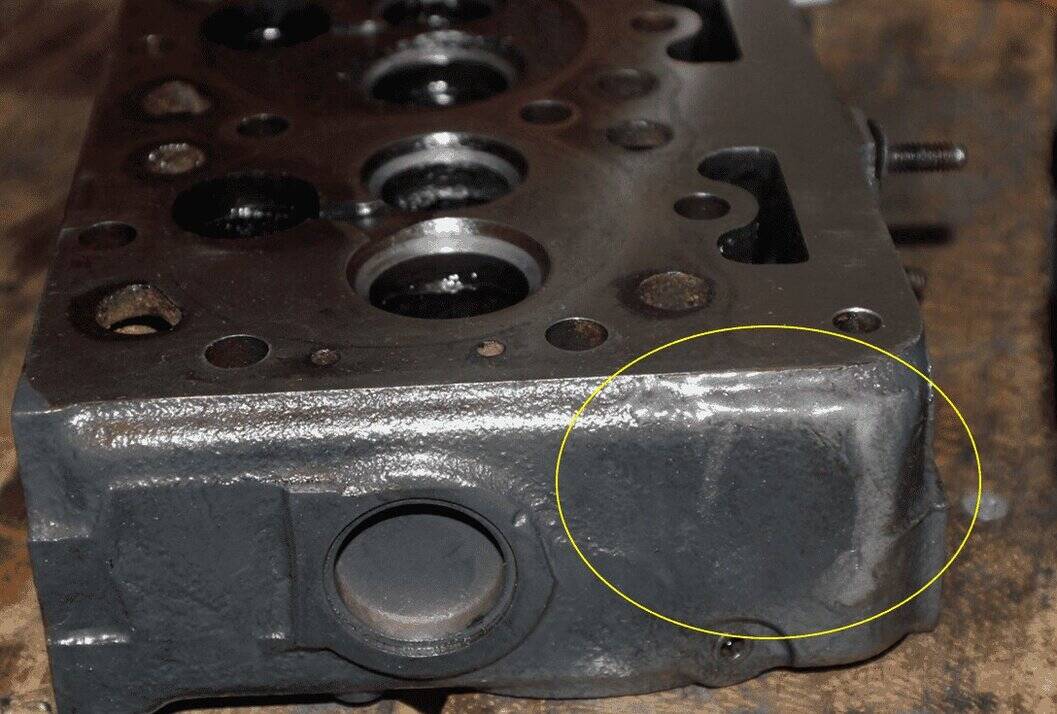
This is the first internal crack I found. It runs well into the valve recess, across the hardened valve seat, along the lower corner of the valley and down into the recessed combustion chamber. This one actually shows a little better in the photo than it does in person. The camera flash must catch it well.

I also discovered this one as well. It crosses the valve seat, and then continues straight into the valley between the ports. It’s harder to see, but its there.

I have purchased some penetrating dye and developer to make finding these kinds of issues at home much easier in the future. I may test it out on this scrap head when it comes in just to see what else shows up!
In the mean time I have ordered a Kumar Bros aftermarket replacement head for this engine. The reviews I could find were mostly positive, and it is quite a bit less expensive than a genuine Kubota one. Hopefully the next update will be a running engine!
Click here for Part 7 on the Kubota B20 rebuild.
Restoring a Kubota B20 Tractor – Part 5
Lots of progress to update!
Two of the cylinders cleaned up to within spec after surface honing. Cylinder #2 had some very heavy pitting, most likely from water sitting in the cylinder. It needed to be re-sleeved.


I took on re-sleeving the cylinder myself, and it was much more work than I anticipated. I removed the old sleeve by carefully chiseling a slit from top to bottom. I stuck the new one in the deep freezer before installing, but it still took several hours of work in combination with additional ice packs to finally drive it in. If I ever to another one of these, I am definitely going to use dry ice.

Another surprise was to learn that Kubota cylinder sleeves are not bored to final size, due to the amount of force they require for installing. I was not able to find a local machine shop that could do the work that wasn’t already backed up several months. I decided to try boring it myself using a neighbors hone that he was sure could also bore. I was skeptical, but to my surprise, with some patience and frequent bore measurements it worked great! This wasn’t the common inexpensive cylinder hones. It had gear driven racks that applied the pressure to the stones and kept them parallel. After several hours of working with it, I had a cylinder within 3 thousands from top to bottom, and side to side, which is within the factory specs.
After flushing all of the honing grit out of the crankcase really well, I changed out all the crankshaft main bearings and seals. I also polished the crankshaft journals.

I ordered the rebuild kit that included new pistons along with the rings. Here is a shot of the crankcase all cleaned up right before putting the oil pan back on.

Next, I resurfaced the engine head and ground and polished the valve seats. One of the exhaust valves needed replacing due to stem wear.

While putting everything back together, I think I found the cause for the original overheating problems. The T-Stat housing had a crack all the way through, in a location that was almost impossible to see when the engine was assembled. It was a pretty expensive part to replace, so I decided to braze it with Allumiweld rods, which are made for repairing aluminum.

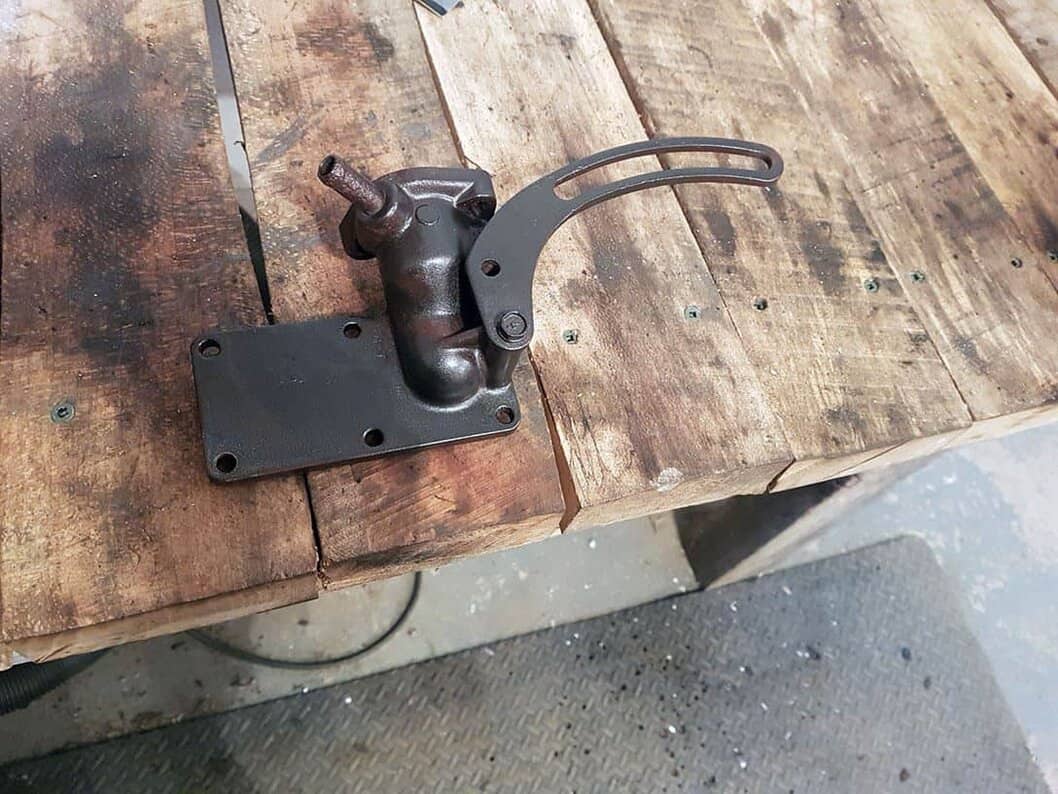
And the final post of updates for now, I have the engine re-assembled and have painted it with primer. It will also be getting a coat of the Kubota Dark Grey Acrylic Enamel before installation.




I am now working on cleaning up and painting the rest of the tractor before putting everything back together again. If anybody knows a good source for Kubota Decals, please let me know!
Click here for Part 6 on the Kubota B20 rebuild.
Restoring a Kubota B20 Tractor – Part 4
I repeated the compression test because I didn’t record the numbers before. In order to perform a compression test (using the injector holes), you will need to remove:
- Air Filter Housing
- Metal Injector Lines
- Fuel Overflow / Bleed Line
- Metal OverFlow / Bleed Line Rail
- Injector Nozzles (make sure to remove the copper gasket from the bore for each one as well)
At this point you can test the compression of each cylinder. While cranking the engine, be sure to pull and hold the engine shutoff rod, so the injection pump is not squirting diesel fuel.You can optionally disconnect the glow plugs power wire to conserve battery as well.
The values I read for each cylinder was from back of engine to front (dry):
80 PSI – 160 PSI – 160 PSI
Since the #1 cylinder was especially low, I squirted some oil in the cylinder and repeated (wet).The value rose to 150 psi, which is a good indication the issue is with the piston rings, and not a valve issue.
The service manual spec for allowable range on compression is 337-448 psi, so all three cylinders are well below spec.

At this point I pulled the head to check for any signs of damage to either the head, valves, or the pistons.
To remove the engine head on this tractor, you will need to (starting with parts already removed for compression test above):
- Drain Oil & Coolant
- Remove Air Filter Bracket & Fuel Filter Mounting Bolts
- Remove Firewall Mounting Bracket Bolts to Head
- Remove Exhaust Manifold (optional)
- Disconnect Fuel Supply Hose to Injection Pump
- Remove Air Intake Manifold
- Remove Glow Plugs
- Remove Top Radiator Hose
- Remove Top Mounting Bolt on Alternator (and swing alternator out of way)
- Move Fan Belt OfF Pulley
- Remove Valve Cover
- Remove Valve Rocker Arm Assembly
- Remove Push Rods (inspect to make sure they are all straight)
- Remove Head Bolts
- Lift Head Assembly from Engine
The engine is quite crusty with carbon deposits, but I don’t seen any signs of head, piston, or valve damage yet. I will post a follow up again once I have pulled the valves apart and cleaned everything up for a more thorough inspection.



Click here for Part 5 on the Kubota B20 rebuild.
Restoring a Kubota B20 Tractor – Part 3
Getting back into this project. We have moved since I started this project and now have a garage bay I can use to continue working on the tractor. I was never able to get it to fully fired up. It would sputter and almost catch but never quite start. I finally did a compression check and was seeing low compression on all three cylinders, with one very low. I am guessing there was some engine damage due to overheating issues it was having back when it was running last.
Since it is going to need a rebuild of some sort, we loaded it up on my trailer and brought it back to my house where I can work on it in the garage.

Once back at my house, I needed to figure out a way to raise the bucket and hold it there so it wouldnt guoge the concrete. Many of the hoses are leaking, so I needed an external way to hold it up. I used a floor jack to lift the bucket off the ground, and a scrap board placed into the linkage to prevent the hydraulic cylinder from collapsing back down worked very well!

Safely in the garage so I can start the engine tear down.

She has definitely seen some wear, and sitting outside has taken a toll too. These pics will hopefully serve as some good “before” pics once I get it back up and running and cleaned up!
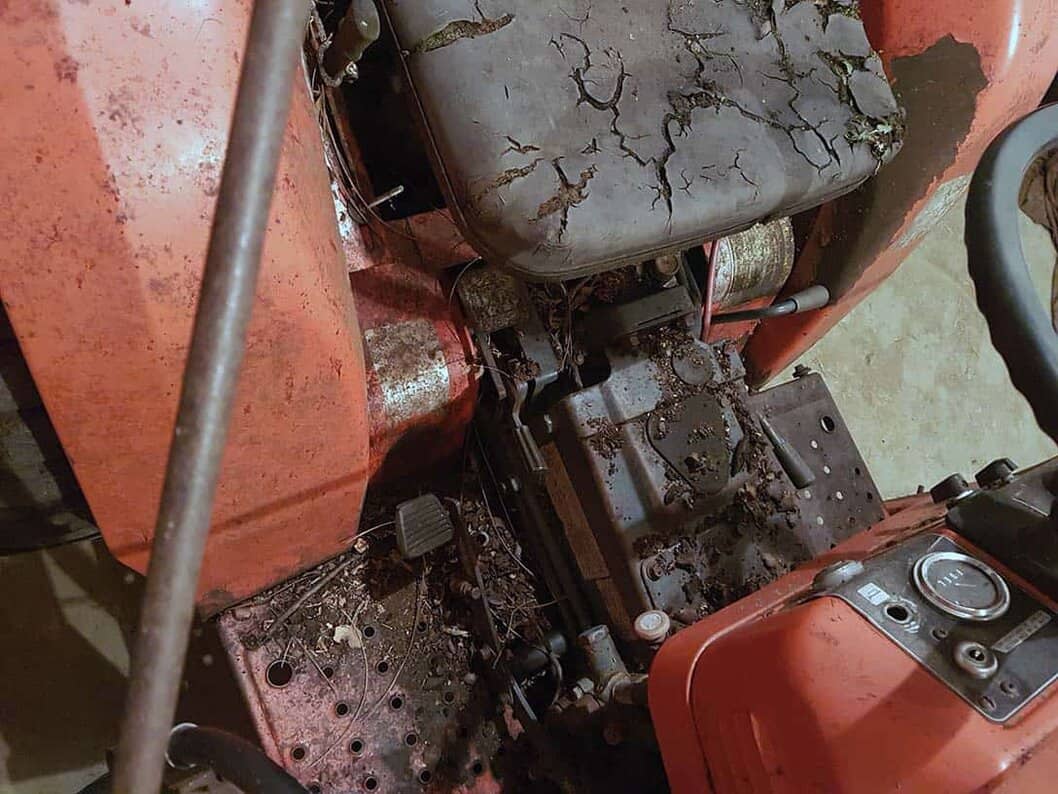

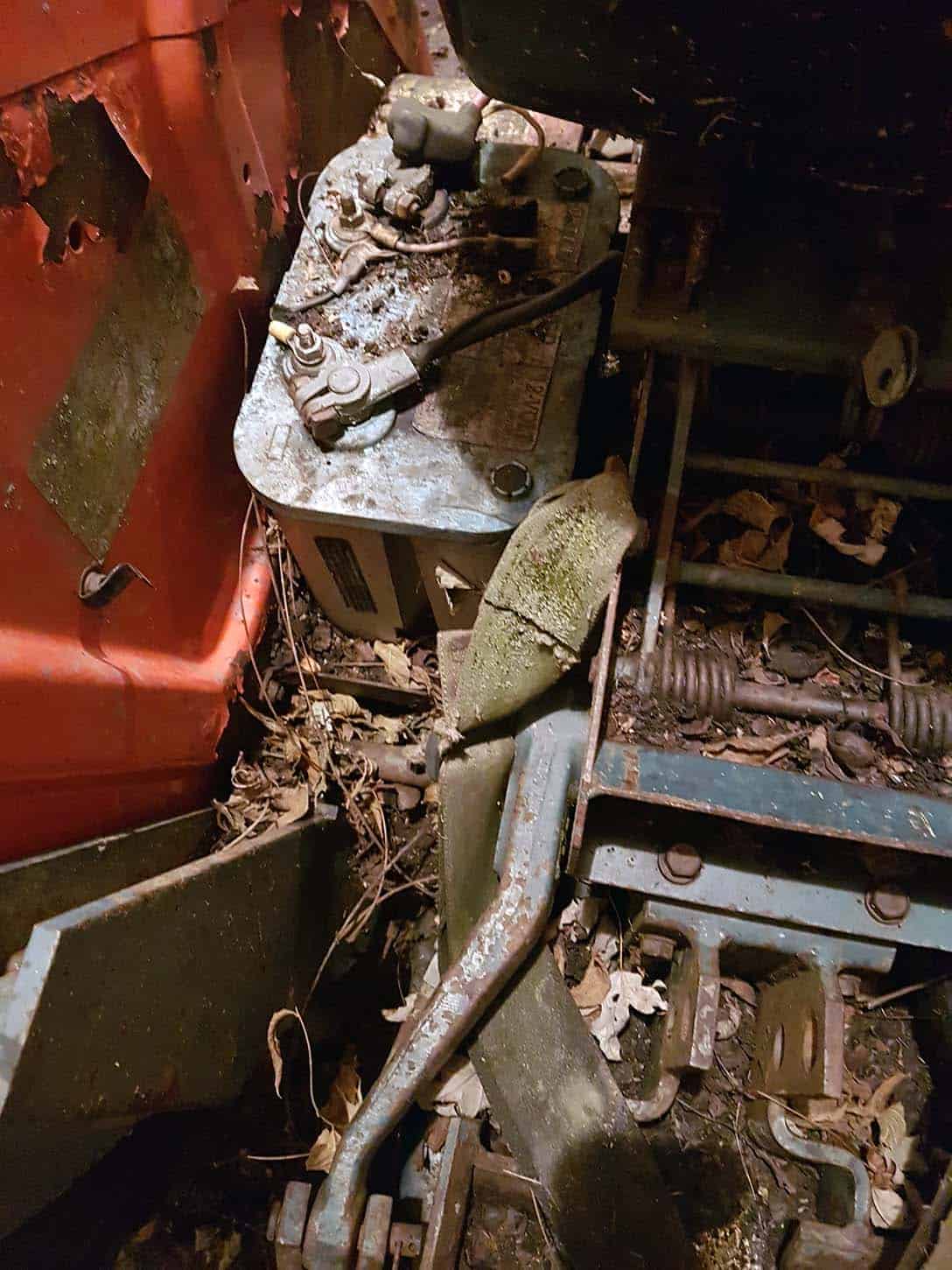

Click here for Part 4 on the Kubota B20 rebuild.
Restoring a Kubota B20 Tractor – Part 2
You can find part 1 on this rebuild here.
Update: I have tires and wheels on the Kubota B20 and aired up. Was able to get 3 of the 4 to hold air with some tire slime. Front left still has a slow leak that I am hoping will seal up once I get it rolling.

Changed the engine oil, oil filter, air filter, fuel filter and radiator fluid.
Engine was completely seized and would not turn over. Removed the injectors and squirted sea foam and engine oil into the chambers to let sit for a couple days. Still wouldn’t crank over with the starter so I used a wrench on the flats of the crankshaft / hydraulic pump shaft coupler to work it loose.

Also needed a new fan belt. Side-note – Not an easy job on these machines. If I ever need to do a belt on a machine set up like this again, I am using one of these:
Engine now cranks over and after lots of working the air out of the injector lines sounds like its firing on one cylinder, but not enough to start. It was in the low 40s (F) when I was attempting, so I plan to give it another try on one of the upcoming warmer days.

